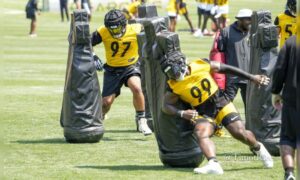By Matthew Marczi
On the negative side, the Pittsburgh Steelers total just one sack through two games.
On the positive side, they are getting to the quarterbacks and influencing throws.
In Week One, the Steelers generated a total of 13 quarterback pressures, according to Pro Football Focus, one of which was a sack. This past week, they failed to register a sack, but they drew pressure 20 times, including five quarterback hits. LaMarr Woodley himself chipped in six pressures, with two of them being hits.
There is an interesting debate surrounding the value of the sack, versus pressure in general. There are many who argue that the sack is overrated and overvalued, and that pressure in general is underappreciated. On the other hand, there are also many people who say to the aforementioned that they are fools.
Frankly, there was evidence to support both parties in the loss to the Cincinnati Bengals.
Of course, the defensive line twice got enough pressure to be able to be in position to bat down a ball, those coming from defensive ends Brett Keisel and Cameron Heyward, the first two batted passes of the year. One could debate as to whether or not batted passes count as pressure, however.
One of the arguments about pressuring the quarterback, and hitting the quarterback, whether or not they statistically register as “quarterback hits”, is that it has a cumulative effect on the quarterback’s psyche throughout the course of the game.
This is a philosophy that the Steelers adhere to, and has been spoken of frequently, though more often with respect to the run game. We should all recall the comments once made by former Steelers linebacker James Harrison about wanting to hurt his opponents, which drew controversy and forced him to make the distinction between hurting a player and injuring a player.
The idea is to hurt other players; yes, it is true. You want the other guys to be bumped and bruised so that they are less enthused as they try to ram themselves up the middle for a two-yard gain. We saw this used with great success a couple seasons ago against Chris Johnson, where it appeared as though he grew tired of the physicality of the game and sort of gave up.
The same philosophy can be applied to quarterbacks. The more a quarterback gets hit, the more gun-shy he gets, and either becomes more willing to give himself up or starts making rushed and poor decisions in getting rid of the ball for fear of getting hit.
Did it work on Andy Dalton? Frankly, it is kind of hard to tell. He has been getting rid of the ball quickly so far this season. Additionally, his accuracy was rather poor for much of the night, and a good deal of his success was due to coverage mistakes. As Dave also pointed out, the Steelers gave up a lot of yards after the catch, which is more on the receivers than the quarterback. Yet, at the same time, he showed the willingness to stand in the pocket and take a shot, which he did multiple times while still making the throw.
Would the Steelers have been more successful if they turned a couple of those hits into sacks? Certainly if they were accompanied with the ball coming loose, that would be an improvement, as they lack a single turnover through the first two games.
Surely it is a tough argument to sell to a team and its fan base that sacks are overrated when they are 0-2 and have but one sack and zero turnovers. But Dick LeBeau has said in the past that constant pressure is better than an occasional sack. While that does not settle the debate, it is certainly a noteworthy position to consider.







